Membership Fee Accounting
Membership fee accounting refers to the process of recording and managing the membership fees collected by an organization from its members. This could be applicable to a wide range of entities, such as clubs, gyms, associations, and subscription-based businesses.
The accounting treatment for membership fees can vary based on when and how they are recognized as income:
- Cash Basis Accounting: In cash basis accounting, membership fees are recognized as income when they are received. For instance, if a club collects annual membership fees upfront at the start of the year, the entire amount would be recorded as income at the time of receipt.
- Accrual Basis Accounting: In accrual basis accounting, income is recognized when it is earned, not necessarily when it is received. If a club collects annual membership fees upfront, instead of recognizing the entire fee as income at once, it would recognize a portion of the fee as income each month over the course of the year. The portion of the fees not yet recognized as income would be recorded as a liability on the balance sheet (usually under “unearned revenue” or “deferred income“) and then gradually shifted to income over the year.
Determining which method to use depends on the financial reporting standards applicable to the organization and the principle of revenue recognition the organization follows. The accrual basis of accounting is generally considered to provide a more accurate picture of an organization’s financial situation, as it matches income with the periods in which they are earned and the expenses with the periods in which they are incurred.
It’s important to note that certain non-profit organizations might have different rules for membership fee accounting, particularly if the membership fees are considered donations. Such cases may require further guidance based on local regulations and standards.
Example of Membership Fee Accounting
Let’s consider a fitness center that charges an annual membership fee of $1,200, paid upfront at the beginning of the year (January 1st).
- Cash Basis Accounting: If the fitness center uses cash basis accounting, it will record the entire $1,200 as revenue immediately on January 1st when it receives the payment. The journal entry would be:
Debit: Cash $1,200
Credit: Revenue $1,200 - Accrual Basis Accounting: If the fitness center uses accrual basis accounting, it will only recognize a portion of the $1,200 each month as it “earns” the income by providing services. On January 1st, the fitness center will record the entire $1,200 as unearned revenue (a liability account), since it owes the member services for the year:
Debit: Cash $1,200
Credit: Unearned Revenue $1,200
Then, at the end of each month, the fitness center would recognize 1/12 of the $1,200 ($100) as revenue for providing that month’s services:
Debit: Unearned Revenue $100
Credit: Revenue $100
This process would repeat each month until, by the end of the year, all of the $1,200 has been recognized as revenue and the unearned revenue balance is zero.
These examples show how the timing of revenue recognition for membership fees can differ depending on whether an organization uses cash basis or accrual basis accounting.













